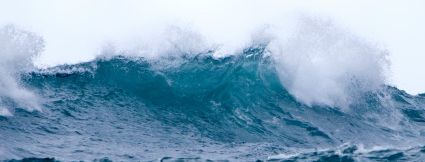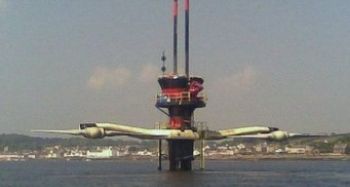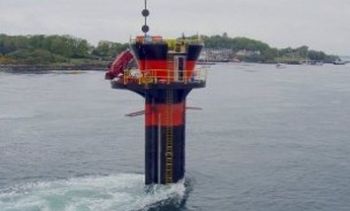|
Tidal Power
Tidal power is another alternative energy source. The daily ebb and flow of tides represent a huge amount of energy. The question is how to harness it. There are already a few commercially active tidal power plants. The largest is at Rance, France and produces 240MW. On this page I discuss different ways of generating power from the flow of tides. I also talk about the drawbacks as well as the possibilities of this source of energy. The existing power plants are of the barrage type, which I explain below. These plants have pointed out both the potential and the problems of tidal power. Other ways of harnessing tidal power are in development in the hopes of maximizing potential while minimizing problems. Barrage Tidal PowerA barrage is in essence a dam across an estuary. Sluices in the dam let water through and turbines in the sluices generate electricity. Power is generated when the water flow in either direction. At high tide, the water is trapped behind the barrage and gradually released through the turbines, generating power in much the way a hydroelectric plant on a river would. Environmental EffectsSince the barrage changes the flow of the tide, it affects the environment. For example, since the barrage slows the ebb of the tide, the mud flats upstream aren’t exposed for as long as normal, thereby affecting the feeding patterns of birds. The change in water flow affects the turbidity of the water which in turn affects algae growth and the rest of the food chain. Barrages also affect fish migration. They can induce changes in the salt level of the estuary. Because of these and other problems, not the least of which is cost, alternative energy engineers are exploring different ways to gather the energy of the tides. Read on. Tidal Stream GeneratorsTidal stream generators operate in the flow of tides without blocking them. In many ways you can think of them as underwater wind mills, with the flow of water caused by tides or ocean current turning the turbines instead of the wind. I’m not aware of a large scale commercial power plant using this system, but Marine Current Turbines Ltd., a UK company, installed a 1.2MW demonstration turbine at Strangford Lough in May of 2008. The plant connects to the energy grid, thereby showing the practicality of this approach Photos courtesy of Marine Current Turbines Ltd.
The picture above shows the turbines at Strangford Lough in the raised position. As you see, there are two turbines supported by the center post. Being able to raise the turbines makes it easier to maintain and repair them. As you'll note, the turbine blades look muck like the blades of a wind turbine.
Here the blades are lowered and only the top of the supporting post shows. Some people oppose ocean-based wind farms because of their appearance. They object to the sight of a collection of towers on the horizon. That, of course, is a matter of taste. I personally don't mind the looks of a wind farm. I also think we have to be willing to make some trade-offs to get clean energy. There's not much showing above the water with tidal stream turbines, so let's hope these sensitive souls won't object to them as well. Look at the base of the tower in the picture and you'll see quite a wake. That's the force of the tide surging around the post. Beneath the surface, that same surge is turning the turbines. Advantages of Tidal Stream TurbinesOne advantage of tidal stream generators is that they don’t interfere as much with tidal flow as a barrage system so the environmental impact is less. It’s also expected that they will require considerable less capital investment. Barrages not only have the disadvantages of their environmental impact, but they are tremendously expensive. A barrage was being considered for a location in England and its estimated cost was 15 billion pounds. There are no plans to proceed with that project at the moment. A lot of research is going on in this field now. Engineers are exploring many possibilities in the hopes of finding the most reliable, efficient and affordable system. For instance, the turbines at the Strangford Lough project are attached to a post drilled into the ocean floor. Other firms have proposed suspending them from anchored barges, or embedding the posts in huge concrete blocks rather than drilling into the ocean floor. Other variables being looked at include adjustable vs. fixed pitched blades, direct drive or gearbox drive and different ways of bring the turbines to the surface for maintenance and repair. Artificial ReefAn artificial reef is somewhat of a hybrid between a barrage system and a tidal flow system. I’m not aware of any full scale demonstration systems in existence. In concept, an artificial reef has a series of turbines along a structure that is much more open to ocean flow than a barrage. It would modulate the flow of the tide and the wave action much the way a naturally occurring reef does. Because it is more porus than a barrage, it would avoid some of the negative environmental effects such as interfering with fish migration or changing water turbidity. Disadvantages of Tidal PowerI mentioned environmental concerns above. I believe these issues are mainly associated with barrage systems and that tidal flow or reef systems will avoid most of them. The main general problem is that tides only flow for about ten hours a day, so the production of energy is sporadic. The other issue is that there are a relatively limited number of places where current systems can operate. But why not use them where we can? Positive AspectsOn the other hand, tides are totally predictable so their power output can be planned as part of an overall energy plan. And as opposed to wind or solar power, things like a change in the weather or cloud cover don’t affect tidal flow. Tidal power produces absolutely no emissions. And its “fuel” – the flow of the tides – is not consumed as electricity is produced. In a sense, a tidal power plant takes gravitational force, as manifested in the flow of an ocean tide, and changes it to electricity. Pretty cool idea to me. SummaryAs I say many times on this site, I don’t think anyone source of alternative energy is “The Answer” to our energy questions. Instead, I think the best answer will emerge from developing a wide variety of ways of generating power and using each where it is best suited. LinksClick here to go to Alternative Energy Primer Home from Tidal Power |


